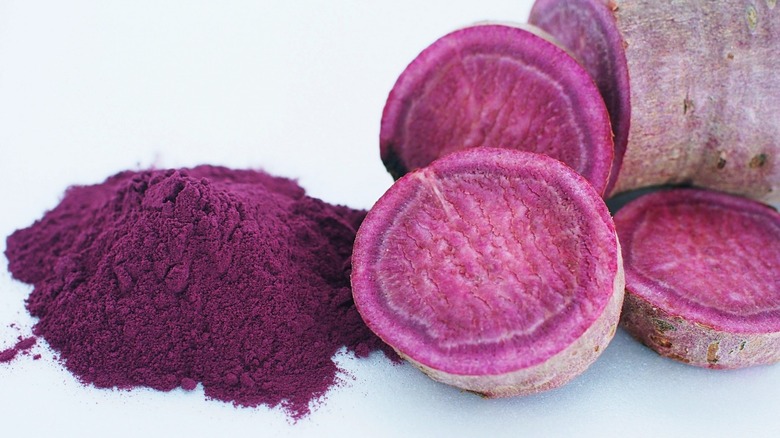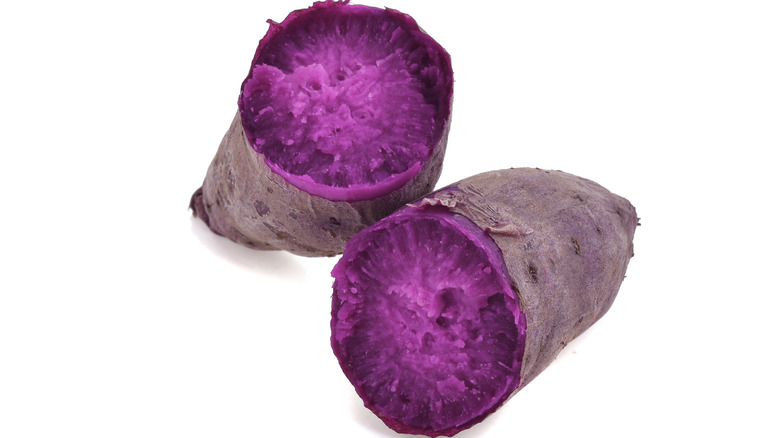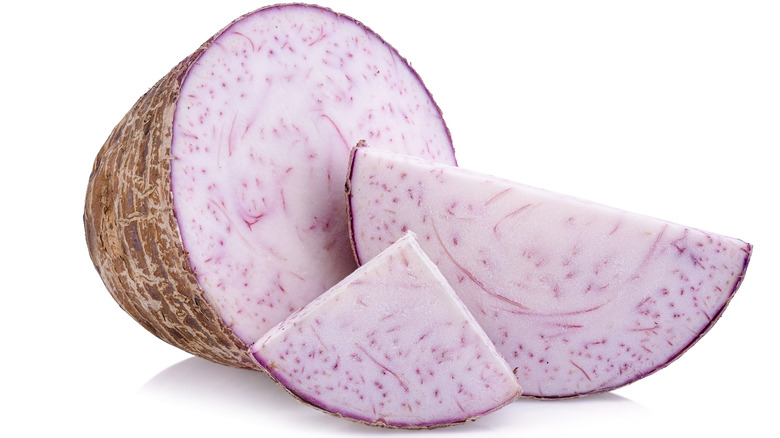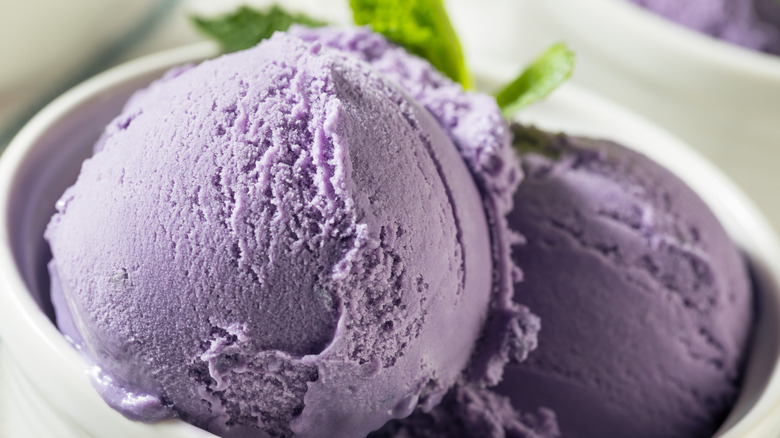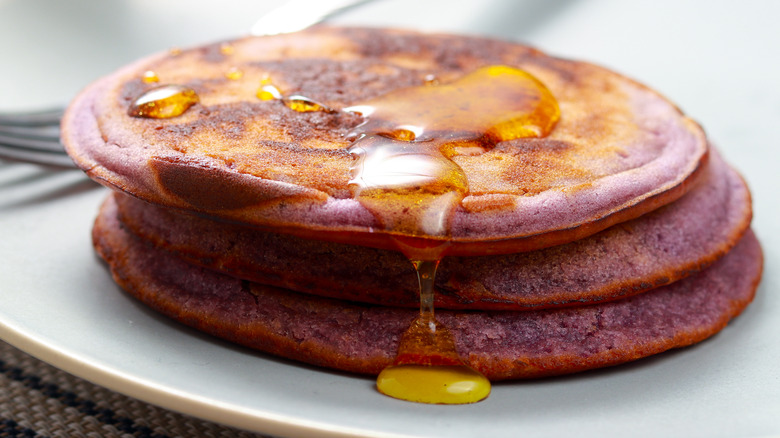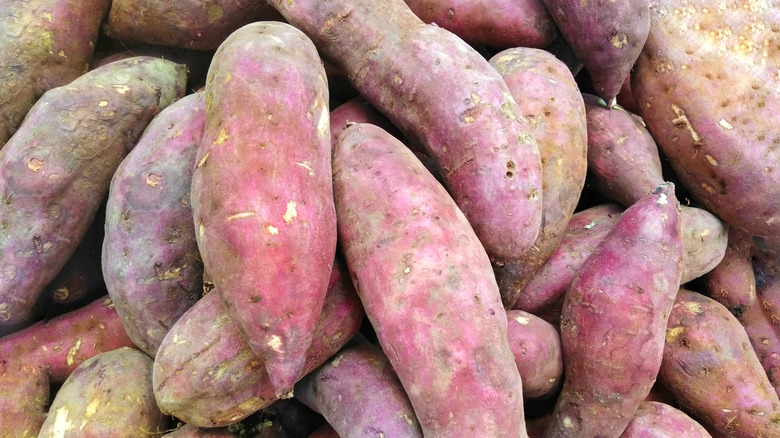Ube Vs. Taro: What's The Difference?
If you've ever slurped taro boba or shoveled spoonfuls of ube halo-halo without knowing the difference, you're in for a real treat. Though they're both starchy plants closely related to sweet potatoes, ube and taro possess different flavor profiles and culinary applications, and are in fact different plants.
Ube is the sweeter of the two; as a result, it is typically reserved to make baked goods and desserts in places such as the Philippines and Hawaii. Comparatively, taro is most commonly used in Asian countries such as Malaysia and China. Slightly less sugary, taro is incorporated in sweet treats as well as more savory fare. Taro has a creamy white flesh that's quite chalky in texture, while ube has a noticeably smooth and dry, deeply pigmented purple flesh.
Below are a few more ways to tell ube and taro apart, plus some ways to cook and eat both of them.
What is ube?
Native to the Philippines, ube (Dioscorea alata) is a starchy purple yam with botanical relations to white-fleshed yams (via Eating Well). The tuber in general has a light purple flesh which deepens to a darker shade of purple when cooked. Many varieties of ube exist featuring slightly different shades, such as Basco ubi, which CNN Philipines describes as having a "cortex [with] a white-purplish tinge;" Zambales ubi, which they share has a pure "purple cortex;" Leyte ubi, which has a "cream to pink cortex with white flesh;" and "the original variety called kinampay." Kinampy ube, often referred to as the "queen of Philippine yams," stands out from the rest due to "its sweet aroma and remarkable taste."
The bright purple tuber has a fairly sweet, but less intense flavor than its orange-fleshed sweet potato counterparts. McCormick characterizes ube's flavor as "mild, slightly earthy and nutty." Furthermore, ube carries a slightly drier, smoother mouthfeel compared to sweet potato varietals most common to the U.S. It's even grown differently; while other tubers are generally grown below the ground, ube grows on a vine above the ground.
What is taro?
Taro (Colocasia esculenta) is very similar looking to the root vegetable ube, but actually produces what is known as a corm (via MasterClass). Originating in Southeast Asia, taro root is a staple ingredient for a spectrum of cuisines across the globe, such as those found in Africa, India, and the Pacific Islands, in addition to its native lands.
The root isn't the only edible part of this plant. People in Hawaii, India, and the Philippines have been known to eat taro leaves. The sprawling heart-shaped greens will not merely provide plenty of beneficial vitamins and minerals (specifically vitamin A and C, potassium, and folate, shares Healthline), but also lend themselves nicely to surrounding ingredients to create a well-balanced, flavorful dish.
Akin to ube, taro comes in many varieties (over 300, reports Big Oven): these corms range in size and have opaque white to very lightly tinted purple flesh. Cooked (you must cook both the taro root and its leaves, because raw taro contains high levels of the toxic compound calcium oxalate, warns MasterClass), the texture of taro is similar that of a sweet potato or a conventional potato. It's slightly gummy, with a subtly sweet and nutty flavor.
Is ube sweeter than taro?
Overall, ube has a slightly sweeter flavor profile compared to taro.
Ube's flavor will ultimately depend on which variety you are eating, but more often than not, it is mildly sweet and often likened to (and combined with) that of vanilla or pistachio. As such, bakers reach for ube when looking to create desserts subtle in sweetness, but rich in complexity.
Taro, on the other hand, shares a similar nutty nuance, but proffers a decidedly gentler sweetness that soaks up other flavors easily. This allows taro to work well in both sweet and savory dishes, in a way ube isn't often used. (McDonald's even offers a sweet taro pie, though, sadly for taro fans and fast food aficionados, only in Hawaii.) As taro is the more savory of the two starches, it serves as a decent swap for white potatoes as well.
What are the culinary uses fro ube and taro?
Both ube and taro can be used in a vast array of dishes, but generally speaking, taro is more often used in both savory and sweet dishes, while ube is reserved for sweet applications. In recent years, though, it is ube that has experienced a surge in popularity (via BBC).
Often featured in treats like pancakes, ice cream, cakes, and donuts, food manufacturers have started to cash in on ube's riotous powers as an ingredient. Trader Joe's, for example, carries ube tea shortbread cookies in addition to a pint of deeply violet, velvety ube-flavored ice cream. Fun fact: TJ's once discontinued its ube ice cream, but (much to the delight of loyal customers) the product made its triumphant return to the freezer section back in Spring 2021. Now, fans of the grocery chain can spot ube products like the aforementioned ice cream and shortbread cookies, as well as Ube Mochi Pancake & Waffle Mix (via Thrillist).
Less of a viral sensation, taro has its own unique culinary merits. The versatile ingredient can be found in chips, crispy pancakes, and stir-frys, along with sweet treats like boba tea, ice cream, and cakes.
How to tell ube and taro apart
Yes, both ube and taro are enticing in their sublime starchiness and they provide a similar (but different!) flavor in beverages, snacks, and meals; but you'll be glad to know that there's a few easy visual cues that make ube and taro quite easy to tell apart. The outer skin of ube is light brown with purple undertones, with a rough texture. Meanwhile, taro often has an even rougher, hairy brown skin with thin white lines running across it.
If you're not observant enough, their outward appearance may seem a bit similar and throw you off; but all that settles when you cut them open and do a side-by-side examination. Ube has a distinctly purple flesh, while taro features a bright, creamy white flesh dotted with small purple freckles.
A good way of remembering it is: ube is uber purple. As for taro? Well, let's just say it's purple in spirit.
